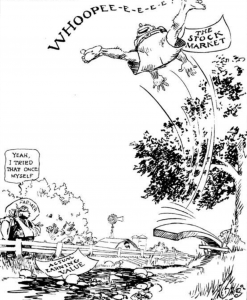“It’s Fine as Long as You’re Going Up”, Cartoonist: Jay Darling, March 1928

In March of 1928, cartoonist Jay Darling published a political cartoon, titled “Its Fine as Long as You’re Going Up,” which shows the risks Americans took in the stock market. The picture shows how farmers, who had taken out loans from banks to partake in the stock market, lost their fortunes similarly to other American citizens. The farmer with a broken arm signifies the damage of attempting quick wealth. The intended audience was the American public, as the aim of the cartoon was meant to warn U.S citizens that investing in the stock market can be dangerous. Before the start of the Great Depression, the stock market was highly volatile, which tricked many investors into thinking they can become rich quickly. In the ’20s, interest rates were very low. With low-interest rates, American citizens could borrow a large sum of money from banks and pay back little interest on the loan(s) [1]. American citizens would take out loans from banks and invest it in the market. Most American citizens lost their money in the stock market, which contributed to the failing of the banks since citizens could no longer pay back loans. This source reveals how inadequate supervision of loans from the Federal Reserve, lead to the greed of American citizens in the stock market, which was a contributing factor in the Great Depression starting in 1929.
“Runs on Banks”, Franklin D. Roosevelt Library Public Domain Photographs, Black Thursday, 24th October 1929.

This photo from Franklin D. Roosevelt Library Public Domain was one of many bank runs that occurred during the aftermath of the most significant stock market crash in history. Dubbed “Black Thursday” this photographs intended audience was the American public as the aim of the photo was to show the conditions after the stock market crash that banks had to cope with. Banks during the crash of the stock market were hit the hardest. The stock market declined more than eleven percent, and the crash frightened investors as it sent shock waves throughout the global economy. “Black Thursday” put all banks at risk as investors were no longer confident in the banking system. People demanded their money be withdraw before the banks failed. Though a surprise to many, this day could have been avoided. The Federal Reserve failed to act on its Monetary and Fiscal policies. The Federal Reserve failed to supervise risky loans from banks and raise interest rates to the level in which would slow spending. With mass amounts of spending, the stock market overheated and eventually lost consumer confidence after the large selloff of stocks on October 24, 1929. Having a low-interest rate means investors could borrow loans from banks and pay back that loan back at a very cheap interest rate. The low-interest-rate created a bubble in the market that happened to explode on Thursday in October of 1929.
“Stories from the Great Depression” U.S National Archives on Youtube, (2009)
This video from the early 1920s through the 1930s, uploaded to YouTube by the U.S National Archives, highlights stories and audio tapes from Franklin D. Roosevelt and American citizens on the ongoing Great Depression. The focus of this video from the U.S national archives is on the conditions after the crash of “Black Thursday.” In the case of this video, the focus is on many unheard stories after the stock market crash, which sent the global economy spiraling out of control. While hearing stories throughout the ongoing Depression about protests, unionism, and hunger strikes might not shock many, it is essential to note that this catastrophe could have been avoided with stronger Government Policy. The Federal Reserve before the Great Depression had a weak Monetary Policy, and the Government should notice this flaw. That is, interest rates were way too low, which spurred on American citizens to borrow loads of money and pay it back at a low cost. If there was a stronger Fiscal policy from the Federal Reserve, such as the use of higher taxes, then that policy could have countered the weak Monetary Policy (of low-interest rates). Increasing taxes would have helped to balance out the economy since the two policies work together as one. Although the Great Depression seemed like just an “event” in history that happened, a few policy changes could have countered the crash of the stock market, which ultimately led to the Great Depression.
Notes:
- Price Fishback “How Successful Was the New Deal? The Microeconomic Impact of New Deal Spending and Lending Policies in the 1930s,” Journal of Economic Literature, no.1 (2017) : 1435–1485.
